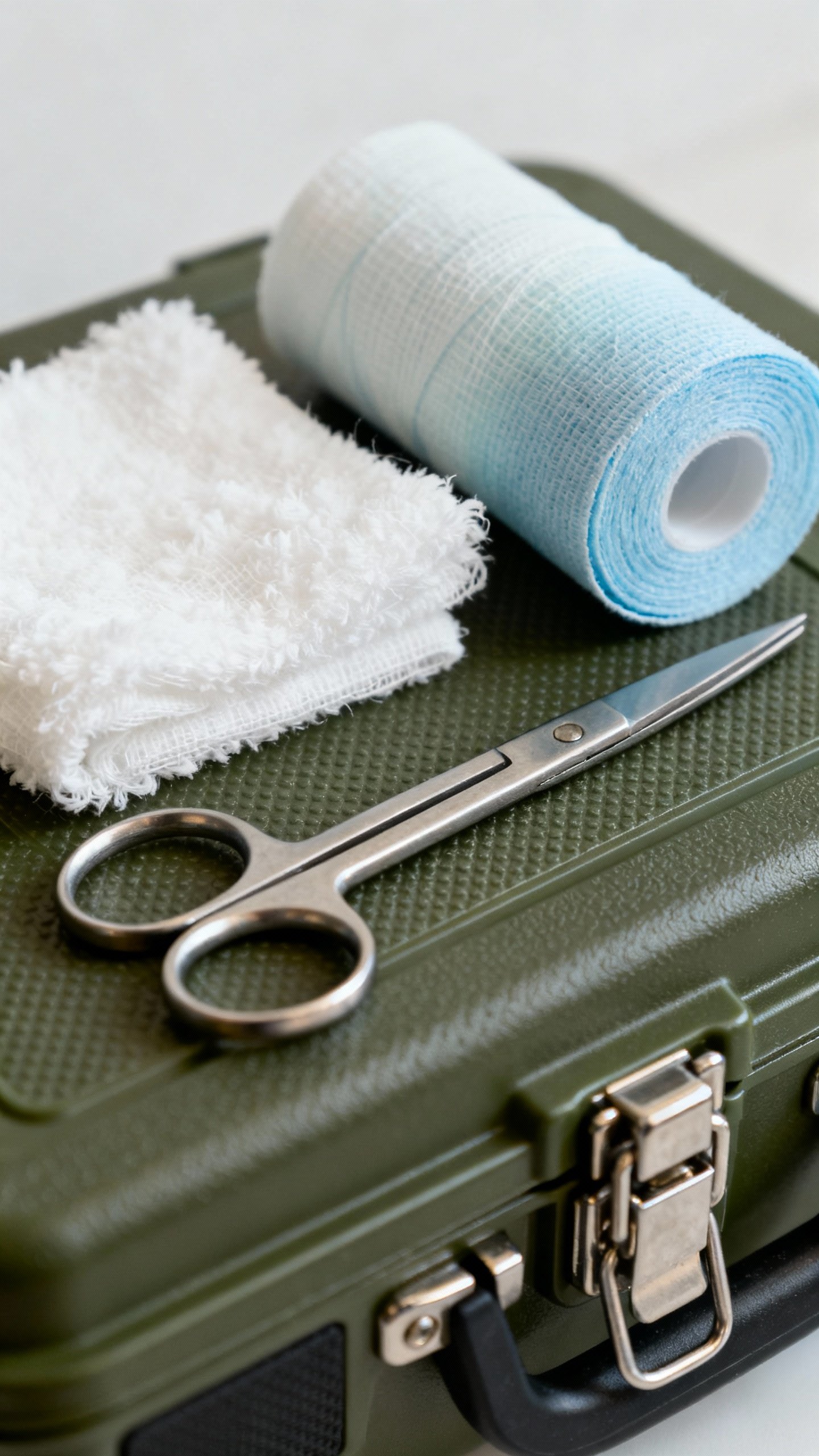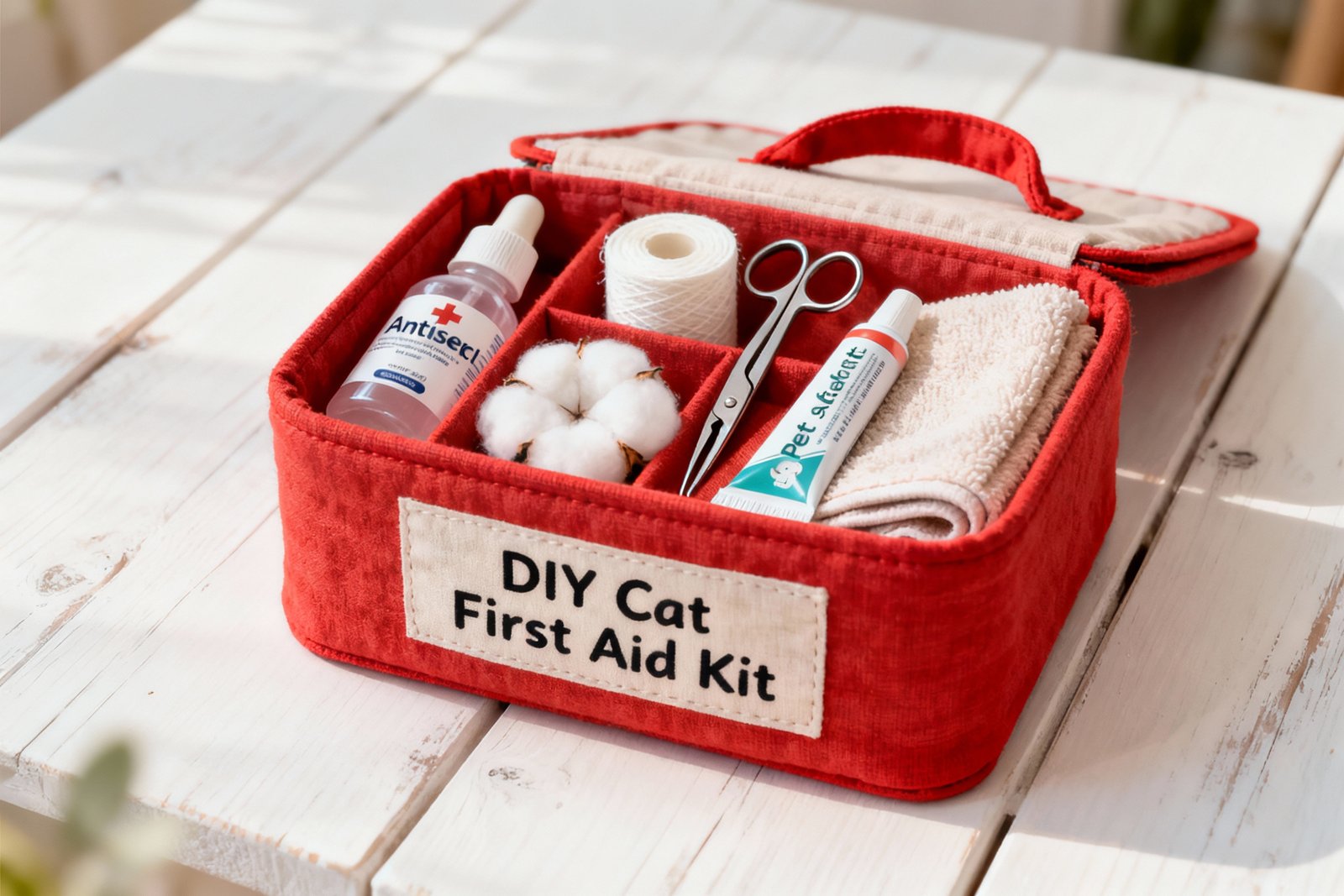“diy Cat First Aid Kit — Everything You Should Have At Home”
You don’t plan to need a cat first aid kit… until your furry chaos goblin eats a houseplant, gets a mystery cut, or decides the curtain rod is a jungle gym. Having a DIY kit at home means you can act fast, stay calm, and avoid the “frantically Googling at 2 a.m.” routine. It won’t replace your vet, but it’ll buy you time and make emergencies less scary.
Let’s build one that actually helps when things get weird.
Start With the Basics: What Your Kit Absolutely Needs

You want compact, reliable, and cat-safe. Stash everything in a sturdy, latching container you can grab fast. A tackle box or small toolbox works great. Core supplies:
- Gauze pads and rolls (sterile, various sizes) – for wounds and pressure bandages
- Non-stick sterile pads – to cover wounds without ripping fur
- Self-adhesive bandage wrap (Vet Wrap) – sticks to itself, not to fur
- Adhesive tape (paper or cloth) – for securing dressings
- Blunt-tip scissors – for cutting tape/bandage without poking your cat
- Tweezers – splinter or thorn removal
- Digital thermometer (rectal, pet-safe) – normal cat temp is 100.5–102.5°F (38.1–39.2°C)
- Water-based lubricant (for thermometer) – aloe vera gel or KY-style
- Disposable gloves – hygiene and safety
- Saline eye wash (plain, sterile) – flushing eyes or wounds
- Chlorhexidine 0.05% or dilute povidone-iodine – gentle wound cleaning (never hydrogen peroxide on cats, it damages tissue)
- Instant cold pack – swelling and minor sprains
- Soft towel or small blanket – for calming, restraint, or warmth
- Slip leash or pillowcase – emergency transport/harnessing
- Small flashlight – check pupils, mouth, and wounds
Vital info to include
- Vet phone numbers: regular vet + 24/7 emergency hospital
- Poison helplines (US): ASPCA 888-426-4435, Pet Poison Helpline 855-764-7661
- Medical records copy: vaccines, meds, allergies, microchip number
Medications That Make Sense (And What to Avoid)
You can keep a few safe meds on hand, but always call your vet before dosing.
Cats metabolize drugs weirdly. What’s safe for you might be a hard no for whiskers. Good to have:
- Antibiotic ointment (without pain relievers) – a tiny amount around, not inside, wounds
- Styptic powder or cornstarch – stops minor nail-trim bleeding
- Diphenhydramine (Benadryl, plain) – only with vet dosing advice first
- Probiotics for cats – tummy troubles from stress or antibiotics
- Electrolyte solution (unflavored) – small sips for mild dehydration until you reach the vet
Absolutely avoid (no debate, IMO):
- Human painkillers – acetaminophen, ibuprofen, naproxen are toxic to cats
- Hydrogen peroxide for wounds – delays healing; also do not induce vomiting without explicit vet instructions
- Essential oils – many are toxic; don’t use topically or diffuse heavily
Dosing note
Write your cat’s weight and any vet-approved doses on an index card in the kit. When you’re stressed, you’ll appreciate the cheat sheet.

Bandaging Without the Drama
Cats and bandages mix about as well as cats and bathtubs.
Use bandages only to control bleeding or protect a wound until the vet steps in. Quick bandage steps:
- Clean with saline. Pat dry.
- Cover with a non-stick pad.
- Wrap gently with gauze, then self-adhesive wrap. You should fit a finger under it—too tight causes swelling.
- Check toes for warmth and color every 10–15 minutes.If cold or puffy, rewrap looser.
- Head to the vet for deep wounds, bites, or bleeding that continues longer than a few minutes.
When to skip bandaging
If the wound is tiny and not bleeding, clean and leave it uncovered so it can breathe. Monitor for redness, heat, or discharge.
Handling Emergencies Calmly (Fake It Till You Make It)
Your cat will read your energy. Breathe, speak softly, and move slowly.
Use a towel to make a kitty burrito if you need to restrain them safely. For common crises:
- Bleeding: Apply firm pressure with gauze for 5–10 minutes. Do not peek every 10 seconds.
- Choking: If they can breathe or meow, don’t stick fingers in there. If they cannot breathe, you can try gentle sweeping only if you see the object.Call the vet immediately.
- Heat stress: Move to a cool area, offer small sips of water, place cool (not ice-cold) damp cloths on paws and belly. Vet ASAP.
- Eye injuries: Rinse with sterile saline, prevent rubbing, and see the vet quickly.
- Poisoning: Call poison control or your vet before doing anything. Bring the label or a photo of the plant/product.
Know the normal
- Temp: 100.5–102.5°F (38.1–39.2°C)
- Heart rate: 140–220 bpm (faster when stressed)
- Respiratory rate: 20–30 breaths/min at rest
FYI, checking these when your cat is healthy helps you spot trouble faster later.

Add-On Gear for Overachievers (Worth It, IMO)
If you want to level up your kit, these items shine during the “oh no” moments:
- Muzzle designed for cats – protects you during painful handling (or use a thick towel)
- Elizabethan collar (inflatable or soft cone) – prevents licking/chewing wounds
- Pet carrier with a top-opening door – easier, safer loading
- Heating pad (set to low) or hot water bottle wrapped in a towel – for warmth after shock or anesthesia
- Tick remover tool – cleaner than tweezers
- Clippers (small) – to carefully trim fur around wounds
Allergy or asthma-prone cats
Ask your vet about keeping a pre-measured dose of diphenhydramine or an inhaler adapter (AeroKat) handy.
Don’t self-prescribe—cats are not tiny people.
Real-Life Scenarios: What You’ll Actually Use
Let’s be honest: most “emergencies” are minor but messy. Here’s how your kit plays hero.
- Clipped a nail too short: Styptic powder, tissue pressure, cuddle. Crisis averted.
- Scrape from parkour attempt: Saline rinse, dab of antiseptic, non-stick pad, quick wrap, vet check if deep.
- Random vomiting episode: Note time/contents, offer water in small amounts after 2 hours, call vet if it continues or cat seems lethargic.
- Weepy eye: Rinse with saline, keep them from rubbing, vet visit if squinting or discharge persists.
- Bee sting: Remove stinger with a card edge, cold pack, call vet about antihistamines before any dosing.
Storage, Maintenance, and a Tiny Bit of Homework
Keep the kit in a cool, dry place that you can reach fast.
Label the box clearly so pet sitters or family can find it without a scavenger hunt. Do these every 6 months:
- Check expirations on saline, ointments, meds, cold packs
- Replace used items immediately after any incident
- Update your info card with current weight, meds, and vet contacts
- Practice taking temp, making a towel burrito, and using the carrier (treats help!)
Travel version
Make a mini-kit for your car: gauze, vet wrap, saline, gloves, flashlight, towel, info card. Emergencies don’t respect zip codes.
FAQ
Can I use hydrogen peroxide to clean my cat’s wound?
Skip it. Hydrogen peroxide damages healthy tissue and slows healing.
Use sterile saline to flush, then clean gently with diluted chlorhexidine or povidone-iodine. If a wound looks deep or gapes, head to the vet.
Is it ever safe to give my cat human medication?
Generally no. Many human meds are toxic to cats, and dosing differs wildly.
Call your vet before giving anything, even “safe” stuff like antihistamines. If in doubt, don’t.
What should I do if my cat ate a toxic plant or chemical?
Call your vet or a poison helpline immediately. Have the product name or plant photo ready.
Do not induce vomiting unless a professional tells you to—some toxins cause more damage on the way back up.
How do I know if a wound needs a vet?
If it’s deep, bleeding heavily, involves a bite, or you see pus, go in. Also see the vet if your cat seems painful, lethargic, or keeps licking the area. Cat bites especially love to get infected fast.
What temperature counts as a fever in cats?
Anything above about 102.5°F (39.2°C) needs attention.
If you see 103°F or higher, call your vet. Pair the number with behavior—hiding, not eating, or panting means “go now.”
How do I safely restrain my cat to check an injury?
Use a towel burrito: wrap snugly with the head exposed, and keep paws contained. Speak calmly and move slowly.
If your cat gets too stressed, pause and try again—or call your vet for guidance.
Wrap-Up: You’ve Got This
A DIY cat first aid kit won’t make you a vet, but it will make you prepared. You’ll stop the bleeding, clean the gunk, and keep your cat calm until you reach professional help. Keep it stocked, keep it handy, and review it twice a year.
Your future self—and your dramatic little roommate—will thank you, IMO.



